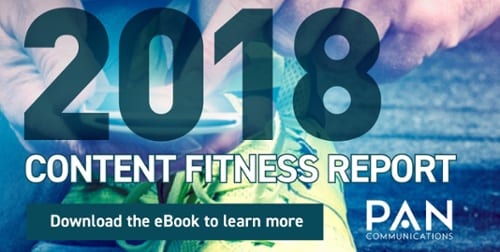In early 2018, PAN Communications surveyed more than 200 marketers for its fifth annual Content Fitness Report. The results delivered insightful and candid revelations about the health of content across various verticals in the marketing industry.
Through these responses, we were able to discern some important points and determine what they mean for the present and future of content marketing. In the key insights below we pulled from the research, you’ll find new opportunities to leverage and ideas on how to break through barriers on topics such as content marketing, buyer personas, martech, influencer marketing, employee advocacy and more.
Get ready to conquer your challenges with a little help from the content marketing community.
Content marketing becomes more integrated, changes dynamics
The 2018 study found that as content marketing becomes more of a backbone of an organization, it prompts marketers to reassess their ‘who’ and ‘why.’ With the who, companies are looking closely at their buyer personas and adjusting them. New personas are being added, because many markets are expanding outside their ideal buyer.
Buyers have become more interested in a brand’s why, especially for those that are sensitive to image and reputation. As a result, many brands are reassessing their positioning to reflect why they’re a better solution over competitors.
The data from the survey found that 47 percent of marketer’s update personas regularly and have content strategies mapped to each. It makes sense that content marketers would put such an emphasis on buyer personas. After all, marketing is evolving to be more personalized because that is what savvy buyers expect.
Data is fueling the development and understanding of buyer personas. There are many more ways for customers to engage with brands, and vice versa. Data helps to guide marketers in the right direction, so they can connect and influence targets at the right time on the right channel. These insights and connections are made possible by having a complete martech stack.
Since buyer personas cover the gamut of marketing activities, this has caused greater alignment with content and overall marketing activities. For example, the survey found that 47 percent of marketers agree their content marketing plan is integrated into their communications strategy.
Content marketing is growing, budgets indicate priorities
Marketing teams are investing more time and resources into their content strategies with social media, influencer marketing and demand generation as top priorities. The full breakdown of budgeting priorities is as follows:
- 60% Content and social media marketing
- 50% Thought leadership
- 45% Demand generation (webinars, events, gated content etc.)
- 45% Digital advertising
- 38% Overall department growth
- 32% Influencer marketing
- 22% Employee and customer advocacy
- 19% Martech investment
Money is clearly a barrier to entry here, while 60 percent deem content marketing as a high priority item only 5-10 percent ended up increasing their content marketing budget.
Not much has changed since 2017 with prioritizing budgets. Last year, we saw creating a variety of media and setting up a consistent pace of content at the top of the list.
Influencer marketing: Opportunities and challenges
Marketers are excited about the possibilities of influencer marketing, but the data reveals challenges as well, mostly around budget and strategy.
Creating an influencer marketing strategy isn’t simple. You must find the right partners that vibe with your brand and your philosophy, make sure they have actual influence, and then measure the ROI.
How can you know exactly what new business or engagement comes from influencer marketing? It can be more complicated to track, but it’s certainly possible, especially when the content is shared and positioned on social media.
You can calculate activity from posts. Finding out if they translated to more revenue is harder. Devise a way to link this information with martech tools so you’ll have more visibility into the results.
Employee advocacy should be a priority
Another challenge for brands in influencer marketing is rallying their own employees. In the survey, 75 percent of marketers said they did not have a strategy for cultivating employee advocacy.
This is a missed opportunity because your own employees can be great advocates on social media as they share posts with their connections. It’s also a positive message to send to customers when they see that employees are proud of their employer.
Video marketing is working, Mobile is still a struggle
Looking at the formats and interfaces of content marketing, marketers reported good results for video, but uncertainty over mobile. Sixty-four percent of marketers said they have found success with video marketing. On the other hand, 33 percent said they do not have a defined mobile-first strategy and are struggling in this department.
Video and mobile both focus on the smartphone and the buyer’s probable obsession with it. This is where they do their research and make decisions. Marketers know video works and that it’s played more on smartphones than any other device. The conclusion could be that mobile-first should focus on video experiences.
Experiences are where the struggle is, and if it’s bad, you’ve likely lost a buyer. The experience between buyer and brand via mobile is critical to their decision to move forward.
Forrester explains there are 30 billion “moments” occurring on mobile across the country daily. That equates to 30 billion opportunities. Being mobile-first is different than just having a responsive website, and it becomes more important every day.
The challenging landscape
When asked about their biggest content marketing challenges, the most referenced areas were determining ROI and keeping up with the competition. ROI continues to be a target that’s hard to hit, with 62 percent of respondents saying that determining it was a major challenge. While this is still a large number, it’s down from 76 percent in last year’s report.
The best way to tackle ROI is to use tools that link campaigns and efforts to results. If you properly track your efforts, you should be able to attribute direct revenue to a specific campaign. Sometimes the connection is vague, but there is great opportunity to expose how contenting marketing fuels sales.
The other challenge to address is competition. Only 21 percent of marketers said they felt they were ahead of the competition relating to content marketing. Content marketing success doesn’t happen overnight. You often have to be patient, which can feel like everyone is passing you by.
It takes time to cultivate and foster an effective content marketing program. When you put in the work, results do come. Remember that overall content marketing is about quality, not quantity. When you have a library of assets that tell great stories and solve problems, audiences will want to read them and know more about your brand.
Being able to count on data in this situation for benchmarking is critical. Once this is done, you’ll have a more accurate view of how your brand stacks up against its competitors.
The remedy for improving your content marketing health
Through the eyes of those that live in content marketing every day, we’ve learned a lot about how companies feel about their efforts. The data reveals possibilities, especially on social media, influencer marketing, video and focusing on mobile-first experiences. It’s also clear that the buyer persona is more important than ever in the discipline. Focusing on their changing needs and where they are should incite more connections.
Explore all the data points and go further into the numbers by reading the entire report here.
 Michael Brenner (@BrennerMichael) has been recognized as a Forbes top CMO influencer, and a Top Business Keynote Speaker by the Huffington Post. He is CEO of Marketing Insider Group, and co-author of 2 books including The Content Formula, and Digital Marketing Growth Hacks. Michael’s innovative leadership has resulted in massive growth for his clients. His workshops and keynotes for Fortune 500 brands and tiny startups have inspired profound personal and professional change.
Michael Brenner (@BrennerMichael) has been recognized as a Forbes top CMO influencer, and a Top Business Keynote Speaker by the Huffington Post. He is CEO of Marketing Insider Group, and co-author of 2 books including The Content Formula, and Digital Marketing Growth Hacks. Michael’s innovative leadership has resulted in massive growth for his clients. His workshops and keynotes for Fortune 500 brands and tiny startups have inspired profound personal and professional change.




